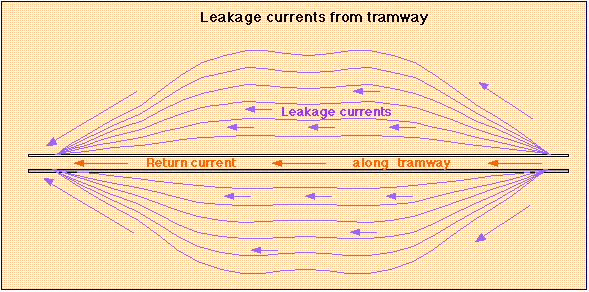
|
|
LEAKAGE CURRENTS and ELECTROLYTIC CORROSION
The electricity supplied to the tram from the single overhead wire has to have a return path to the power source so that there is a complete circuit. This path is invariably through the metal rails on which the tram runs.
Although tram rails are of large cross sectional area, they have to be made of hard-wearing steel alloy which gives them significant electrical resistance. This resistance can result in several volts difference in potential between the ends of a length of track when a large current is flowing.
If one end of the track is well connected to earth, the other end has to be at some (small but unavoidable) voltage above earth. Under these circumstances, some of the current will tend to leave the track at far end, and other points along the track length, and find its way back through the soil. These currents are termed 'Leakage Currents'

Leakage currents can be minimised by good rail bonding.

Pipes, the metal sheaths of cables and the steel reinforcement in the foundations of buildings can all be attacked and it is a matter of great concern to any tramway to ensure that it is entirely blame-free in this respect.
This problem was first tackled in the 1890s and the necessary precautions have been well known until recently.
An article on the subject is available on the Light Rail Transit Association's website and is well worth reading for a fuller understanding of the problem.
The formula for the amount of metal removed from a structure is:
|
Mass removed (grammes) = (Ampères x Seconds x Atomic weight) / (96540 x Valency) |
|
|